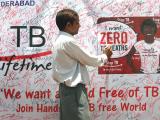Oct 18, 2012 (CIDRAP News) – Several developments are having an impact on reducing tuberculosis (TB) infections and deaths in several countries, but the disease's burden is still enormous, and response to multidrug-resistant TB (MDR-TB) remains slow, the World Health Organization (WHO) said yesterday in its latest report on the global TB situation.
WHO experts estimate that TB care and control interventions have saved 20 million lives over the past 17 years, according to the 272-page report. It comprehensively assesses several TB measures across 204 countries and territories in addition to covering clinical, research, and financing developments.
Dr. Mario Raviglione, who directs the WHO's Stop TB Department, said in a press release yesterday that 51 million people have been successfully treated and cared for on the basis of WHO recommendations over the past 17 years. "This milestone reflects the commitment of governments to transform the fight against TB," he said.
The number of new TB infections dropped 2.2% between 2010 and 2011, and the world is on track to reach the target of cutting the number by 50% by 2015, the WHO report said. However, in 2011 the disease caused 8.7 million new infections and 1.4 million deaths.
Progress in the TB battle varied in different parts of the world, according to the WHO. For example, though disease burden dropped in all six WHO regions, the African and European regions aren't on the path to halve TB deaths by 2015. On the other hand, the report points out that notable progress can occur even in high-burden, low-income countries such as Cambodia, which has seen a 45% decrease in prevalence since 2002.
Identifying patients with MDR-TB remains a top concern, according to the report. Though the number of MDR-TB case notifications has increased in 27 countries responsible for most of those infections, the WHO projects that current efforts are only identifying 1 in 5 (19%) patients who are thought to have MDR-TB.
In 2004 the WHO first recommended that countries coordinate their TB and HIV activities, and those efforts have saved 1.3 million lives since then, according to the group's latest estimate. It singled out Kenya and Rwanda as top performers in testing TB patients for HIV and providing antiretroviral therapy for HIV.
A rapid molecular test called Xpert MTB/RIF that can diagnose TB as well as rifampicin resistance in 100 minutes has been useful, with 1.1 million tests purchased by 67 low- and middle-income countries as of the end of June. The price of the test dropped 41% in August, which should speed its uptake even more, the report said.
New or repurposed drugs aimed at TB and MDR-TB are in clinical trials and under regulatory review, and 11 vaccines against the disease are in development, according to the WHO. New drugs, the first in 40 years, could be on the market as early as 2013.
The WHO put a price tag on funding gaps for TB, one for care and control and one for research. It said that over the next 2 years $8 billion will be needed to prevent and treat the disease, but it estimates the financial shortfall at $3 billion each year.
Dr. Katherine Floyd, who coordinated the WHO report team, said in the WHO press release that the funding gap threatens TB care and prevention, especially in low-income countries.
For research and development, the WHO put the funding gap at $1.4 billion per year.
XDR-TB research
In a TB research development today, a study published in the New England Journal of Medicine of patients with extremely drug-resistant TB (XDR-TB) found that linezolid was effective when added to the patient's existing treatment regimen. The study was funded by the National Institutes of Health (NIH) National Institute of Allergy and Infectious Diseases (NIAID), and South Korea's health ministry.
The study included XDR-TB patients at two South Korean hospitals who had no response to any treatment in the 6 months before the study. Patients were randomized to immediately receive 600 mg of linezolid once a day in addition to their other treatment or to start the drug after a 2-month delay.
After 4 months, 79% of the patients in the immediate-start group and 35% in the delayed-start group no longer tested positive for TB. After 6 months of treatment, 87% of all patients no longer tested positive.
Few patients developed resistance to the drug. However, 82% of patients experienced significant adverse events, including bone marrow suppression and peripheral and optic neuropathy. In most instances, symptoms resolved after briefly stopping the drug or halving the dose.
Researchers said more studies are needed to define the role of the drug in MDR-TB and XDR-TB treatment and to identify a dose that is effective but doesn't provoke significant side effects.
See also:
Oct 17 WHO global TB report
Oct 17 WHO press release
Oct 18 N Engl J Med abstract
Oct 18 EurekAlert press release on N Engl J Med study




















